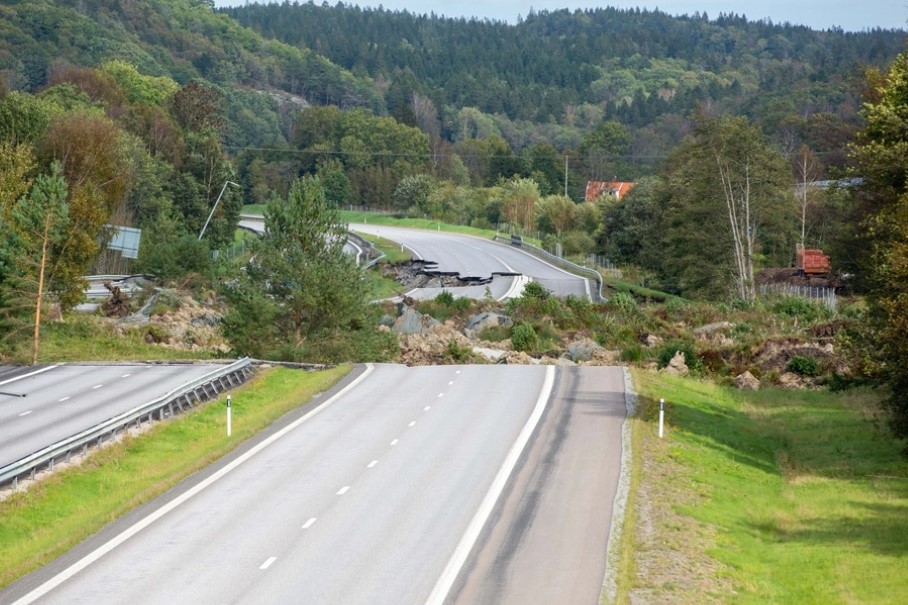A significant landslide that destroyed part of a highway in southwest Sweden may have been caused by excavated material placed on a site at the top of the slope, some landslide experts have said.
The major incident at Stenungsund last Saturday (23 September) destroyed large parts of the E6 motorway which connects Gothenburg in Sweden to Oslo in Norway.
Emergency services were alerted to the landslide at 1.48am, which followed a period of heavy rainfall.
It affected an area of approximately 700 x 200m, about 10 vehicles, a wooded area, and a business area with a gas station and a fast food restaurant, Greater Gothenburg emergency services confirmed.
The large landslide on the E6 at the height of Stenungsund Smotet was around 150m long and is believed to have caused the road to move more than 50m in some places.
Swedish news website Afdonbladet has reported that three people were taken to hospital with minor injuries after their cars got stuck in the landslide.
The Swedish Geotechnical Institute (SGI) and emergency services worked together to secure the affected area following the landslide and rescue services ended their operations on 26 September.
The County Administrative Board has implemented cordons and access bans in the affected area, based on SGI’s geotechnical assessments. It has warned that the ground is still unstable and there is a risk of new landslides.
The cause of the landslide has not yet been investigated, according to the SGI.
However, some landslide experts have speculated that heaps of excavated material placed on the top of a slope by the side of the highway may have led to the failure.
Images of the nearby construction site appear to show a very high embankment of fill material.
Commenting on the images, landslide expert and University of Hull vice-chancellor Dave Petley wrote in his blog: “It is clear that there was extensive works occurring in the upper portion of what has become the landslide, which is being described as a landfill operating with permission.”
“An initial working hypothesis would be that the mass of material deposited on what has become the headscarp of the landslide has destabilised the slope, triggering failure. The weather conditions at the time were rainy, and there has been heavy rainfall in recent days, but this has not been exceptional.”
The owner of the company that has been singled out for placing excavated material on top of the hill has said that it built according to planning permission, Aftonbladet reported on the weekend.
Another large landslide on 20 December 2006 which occurred on the E6 at Munkedal – just 5km north of Saturday’s landslide – was found to be triggered by excavated masses from a nearby highway construction.
Sweden-based GEN Monitoring geotechnical engineer Jorge Yannie agreed that the cause of the landslide was “most likely some man-made works”.
Speaking to GE, he pointed out that heavy rain and “bad geological conditions” in the area – characterised by soft and quick clays with depths varying between 10-30m in the failure area – were also likely to have significantly contributed to the failure.
“The construction work disturbed the equilibrium in the soil and the additional rain probably exacerbated the problem by reducing the clay undrained shear strength,” Yannie said.
“The additional load on the ground probably triggered a local failure that later spread as a “progressive failure” in the area. This is a very common type of failure for the very soft and quick clays in Sweden and Norway.”
He added: “Rainwater accumulates in this small valley, both in the upper and lower aquifer, increasing the pore water pressure in the clay, therefore decreasing its strength.”
Indeed, the area where the landslide occurred is classified as high risk for landslides at a national level in Sweden.
According to Yannie, previous InSAR measurements show large creep/consolidation settlements on and around the main E6 road.
“The latter was an indication of poor site conditions and the presence of a pore water pressure bubble, which decreases further the undrained shear strength of the clay.”
If the correct monitoring had been in place, Yannie believes that early warnings could have been sent before the failure.
“A wide scale warning sign should be combined with local action plans for multiple purposes”, Yannie wrote in a LinkedIn post following the landslide.
“First, to verify that there is a real on-going problem, second to provide a more accurate warning if things get worse and third to try to mitigate the damage and loss of lives.”
The rescue service, the municipality of Stenungsund, the SGI, the Swedish Transport Administration, the police and others have been working together to analyse the situation and plan further work.
A police investigation into the causes of the landslide is currently underway.
Source : Ground Engineering

